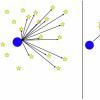Tristerin, which is about 92.1% stearic acid, has a food-energy value of 3 kcal/g.
Conclusion--given the facts, and the assumptions that I've used, it probably isn't unreasonable to conclude that "pure" mango butter actually does have a food-energy value of 35 kcal/tbsp, as claimed, and that those mango butter products citing 35 kcal/tbsp (Calories/tbsp) aren't diluted/adulterated--assuming the manufacturers/vendors are honest and careful.
Tristearin bioavailability
The 3 kcal/g food value (instead of 9 kcal/g) for tristearin in this mouse feeding experiment Energy Value of a Fat High in Stearic Acid results from poor tristearin bioavailability. The stearic acid content of mango butter thus appears to be in this form (tristearin = a triglyceride with 3 stearic acid molecules hooked to glycerol) and has poor bioavailability.
Bioavailability of tristearin and Salatrim 23CA (triglyceride with stearic acid & a SCFA)
Excerpts from The absorption of stearic acid from triacylglycerols: An inquiry and analysis "Solubilisation of high-melting-point tristearin in low-melting-point oils improves the digestibility of its stearic acid, particularly when emulsified or liquidized at above melting point. However, without such artificial aids, the digestive tracts of the rat, dog and man have a low capacity for emulsifying and digesting stearic acid from tristearin." ... "The efficiency with which human subjects digest stearoyl from cocoa butter still remains uncertain, while the digestion of total long-chain fat from this source is 0.89-0.95 g/g, high in comparison with 0.33 g/g for Salatrim 23CA and 0.15 g/g for tristearin" ... "The low digestibility of stearoyl in Salatrim 23CA, together with the occurrence of short-chain organic acids in this product, account for its relatively low nutritional energy value (about 20 kJ (5 kcal)/g) compared with traditional fats (37 kJ (9 kcal)/g)
When stearic acid is not part of a triglyceride, its bioavailability can be quite good "Of twenty-eight studies conducted in adults ... the 'true' digestibility of stearoyl is 0.98 (SE 0.01) g/g" over a range of 0.05 to 0.65 g/kg
Edited by RWhigham, 22 August 2018 - 11:28 PM.
































 This topic is locked
This topic is locked





























